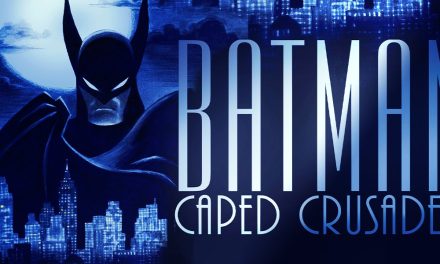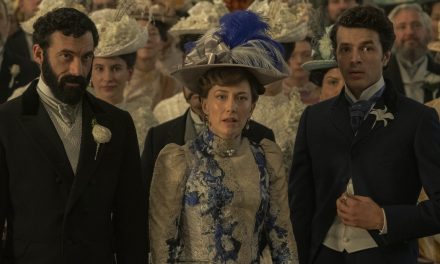Weeks of mysteries, recurring characters, and ominous quotes all come to a head with ‘The Legend Of Ruby Sunday,’ the first of an explosive two-part finale for Doctor Who. The 45-minute episode sags under the weight of eight episodes of build-up.
The Doctor and Ruby barge into UNIT, still in their Avengers toweresque building with a big Disney + upgrade in set-up. Kate Lethbridge Stewart (Jemma Redgrave) is joined by a returning Rose (Yasmin Finney) and Mel (Bonnie Langford) alongside a 13-year-old genius called Morris (Lenny Rush) to keep a watch on planet Earth when The Doctor is away. This world-building is one of the better aspects of this New Who; which acknowledges that The Doctor can’t always be there to save the day, so someone has to stay behind to clear up the mess.
They aren’t at UNIT for a cup of tea; they have noticed a common thread on their travels. The time-traveling duo has seen enough of a mysterious woman through time to know that it’s more than just coincidence. Susan Twist has appeared in every episode throughout season 14, and despite showrunner Russell T. Davies claiming the UK had run out of actors, it was clear she would be key to the series.
First, Twist cropped up in the opening scenes of ‘Wild Blue Yonder’ as a maid accompanying Isaac Newton before appearing as one of the humans who abandoned the spaceship in ‘Space Babies.’ In episode 2, ‘The Devil’s Chord’, the actress is credited simply as ‘Tea Lady’ – appearing in the cafeteria before popping up an episode later as an ambulance in ‘Boom’ and a hiker in ’73 Yards.’ Only in ‘Dot and Bubble’ did The Doctor and Ruby clock that this woman had been appearing throughout time.

Twist appears in a more significant role in ‘The Legend of Ruby Sunday’ under the guise of Susan Triad. The start of the episode sets her tech mogul up as the episode’s main villain, but really, she is just a vessel for the true evil. Russell T. Davies plays the internet sleuths at their own game, letting The Doctor repeat the more obvious theories before the truth turns them on their head.
Another thread running through the season was The Doctor opening up about his family. When audiences first met the timelord (played by William Hartnell) in 1963, he was traveling with his granddaughter Susan. She has not been greatly spoken about since the show was rebooted in 2005. Susan gets more mentions this season than the last 13 seasons, but is this just a red herring? Davies knows how to play with the expectations of avid Doctor Who fans who are always looking for clues in the subtext; he himself a lifelong aficionado of the show.
The show also addresses the other season 14 mystery: who is Ruby Sunday? The companion is so much more than a standard Mancunian traveling time and space with The Doctor. Abandoned on a snowy Christmas by a mysterious cloaked woman, something about Ruby’s back story is far bigger than a sad tale of adoption. As she travels, she is haunted by snow, falling down and disrupting reality.

This episode has a lot to address and mostly balances it out. Ruby and The Doctor use a time portal to revisit the night Ruby was left on a church doorstep. The duo gets tantalizingly close to the truth but not enough to feel satisfying. A lot of time is spent on this enigma, the mystery of the cloaked woman ramping up; yet it never really addresses the questions audiences are gasping to have addressed. While some of the best moments in Doctor Who come from the unresolved, this doesn’t feel like it should be one of those moments.
After the bold choices made throughout the season, seeing Doctor Who returns to its old formulaic ways feels disappointing. For all the narrative innovation and sharp wit used throughout the 14th season, this episode brings back a classic monster and a classic set-up. In many ways, Doctor Who has moved past running down corridors while a CGI monster clomps behind them.
The show had displayed hints that it had moved on from running down hallways away from generic baddies. The villains this season had shown something different, including the twist at the end of ‘Dot and Bubble’, which revealed who the true bad guys were, and the cosplay-loving bird-creatures in ‘Rogue.’ For the whole season to culminate in this feels a little deflating. This is just part one of two. So perhaps the show has somewhere exciting to take audiences next week because audiences know that Doctor Who can do better than this.
The finale feels like a classic Doctor Who episode, using the well-loved formula to decent effect. Sadly, it just doesn’t match the emotion of ‘Boom’, the creepiness of ’73 Yards’, or the social consciousness of ‘Dot and Bubble.’ It’s not unenjoyable, but it feels like a downgrade compared to the greatness of prior episodes.
For more updates on Doctor Who, check back to THS.

![Doctor Who ‘The Legend Of Ruby Sunday’ Sticks To Its Monster Defeating Formula [Review]](https://www.thathashtagshow.com/wp-content/uploads/2024/06/05eeb753-4fe2-4175-993b-83f786bbc35f-1280x640.jpg)


![Black Butler -Public School Arc- Ep. 7 “His Butler, Final Match”: Cricket Without Honor [Review]](https://www.thathashtagshow.com/wp-content/uploads/2024/05/black-butler-440x264.jpg)
